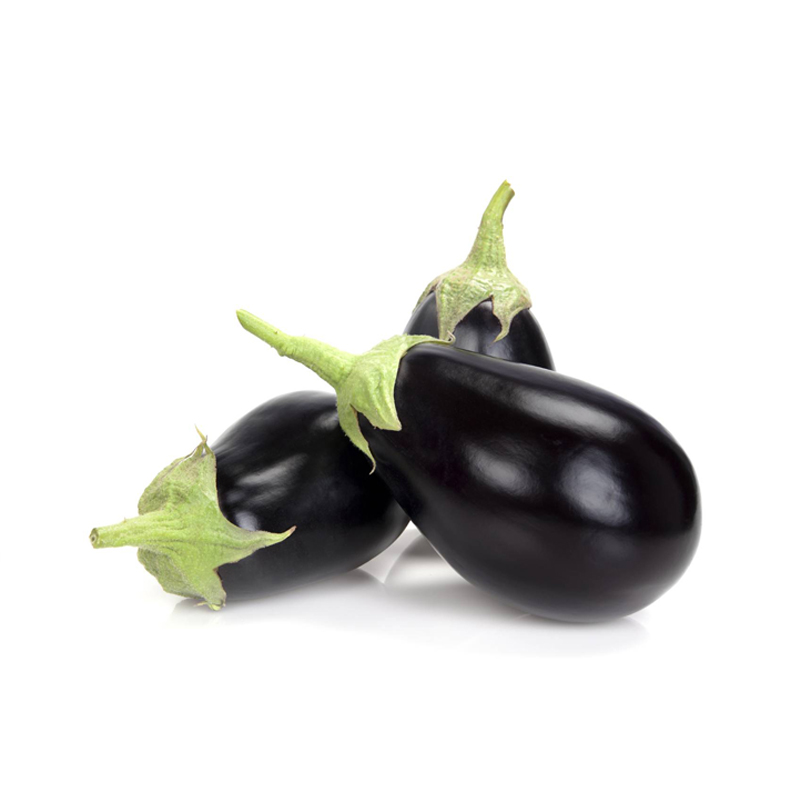
Key features
Regarding energy intake, eggplant is one of the least-calorie vegetables: it indeed brings about 18 kilocalories (75 kilojoules) per 100 grams, which puts it at the tomato, endive or lettuce. It is rich in water (more than 92% on average), and its energy-content is limited.
It thus contains 3-4 g to 100 g carbohydrate (mainly simple sugars, glucose and fructose), and less than 1 g protein, that is rather less than in other fresh vegetables. Lipids, or fatty substances, appear to trace.
Read more
The carbohydrate content of eggplant depends on the variety but also the degree of ripeness: eggplant harvested too early are low in carbohydrates (sometimes less than 2 g per 100 g), which is unfavorable for the taste.
The fibers of eggplant are quite abundant: 2.5 g per 100 g. They are composed mainly by proto-pectin (pectin related to cell walls of plants), and to a lesser extent by pectin and cellulose. When cooking, the proto-pectin, such as pectin, acquire a soft consistency and tender.
Among the minerals (which reach a total of 0.5 g per 100 g), potassium dominates (260 mg per 100 g), while sodium does not exceed 3 mg: this gives the eggplant diuretics undeniable qualities. Because of its low energy intake, eggplant has a good mineral density (mineral content per 100 kcal) is the case for magnesium (72 mg/100 kcal), zinc (0.6 mg / 100 kcal), manganese (0.8 mg/100 kcal).
Vitamins are well diversified group B vitamins, vitamin E (tocopherols plants), provitamin A in small quantities and of course vitamin C (at rates ranging between 2 and 8 mg per 100 g, depending on varieties and seasons).
Other components are also present in small quantities in the eggplant. This is the case of organic acids (up to 400 mg per 100 g, with the dominant malic acid), gallic tannins, more or less abundant depending on variety, which are largely responsible for a certain astringency, and a browning of the pulp to the air.
And finally, like all plants belonging to Solanaceae (including tomato, potato eggplant …), contains natural steroids to trace. These substances, yet difficult to extract and identify, have a characteristic smell (which somewhat resembles the smell of “earth”), and a rather bitter taste. They are concentrated mainly in the green portions of eggplant in the leaves and roots of the plant.
THE NUTRITIONAL AND DIETARY
Eggplant contributes to strengthening the supply useful compounds (minerals, fiber, vitamins), without significantly increasing energy intake. It indeed has a high nutrient density of these elements. To take advantage of this property, it is obviously preferable to cook with minimal fat.
Eaten plain, simply steamed or stewed, pureed and possibly, the eggplant is very digestible. Its fibers (mainly pectin) are indeed well tolerated by the intestine, they facilitate the smooth functioning. Added a touch of garlic and a touch of olive oil, eggplant declared his belief in the “Mediterranean diet”, to be particularly beneficial for health.
Studies in the United States and Austria have shown that the eggplant was able to limit the increase in fat and cholesterol, an increase that usually follows the absorption of fat (and foods high in fat). According to researchers, the eggplant would contain substances (special fibers, specific compounds) Having the property to keep the cholesterol in the lumen. This would be deported to cholesterol without being reabsorbed by the mucous membrane, and then dragged into the bloodstream.
THE AVERAGE COMPOSITION TABLE
Average composition * for 100 g net
Components (g)
Carbohydrates: 3.50
Proteins: 0.90
Water: 92.2
Fibers: dietary2.50
Minerals: (mg)
Phosphorus: 21.00
Calcium: 10.00
Magnesium: 13.00
Sulfur 9,000
Sodium: 3,000
Chlorine:55.00
Iron:0.300
Copper: 0.050
Zinc: 0.110
Manganese: 0.150
Nickel: 0.010
Iodine: 0.004
Vitamins(mg)
Vitamin C (ascorbic acid): 5,000
Provitamin A (carotene): 0.030
Vitamin B1 (thiamin): 0.040
Vitamin B2 (riboflavin):0.050
Vitamin B3 or PP (nicotinamide): 0.600
Vitamin B5 (panothenic acid):0.230
Vitamin B6 (pyridoxine):0.090
Vitamin B9 (folic ac):0.020
Vitamin E (tocopherols): 0.030
Energy intake KCalories: 18.00
* This is an average composition for information: the values are to be regarded as orders of magnitude, which vary depending on variety, season, degree of maturity, growing conditions, etc.. From: “Global Directory of Food”, REGAL (1995) – “Minerals” (1996), “Composition of Foods”, Marigold, Fachmann and Kraut, “The Composition of Foods”, Mc Cance and Widdowson.

Harvest From Epoque


Period of Marketing


